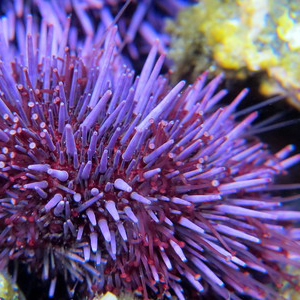Purple Sea Urchin
Though not especially sharp, purple sea urchin spines are strong enough to wear away bits of rock.
 Over time, generations of urchins form the shallow pits they live in. The urchin hangs on to the rock and to the bits of shell and rocks that you might see on the urchin, with tiny tube feet that make up part of the soft tissue between the spines. The pits are great refuge from roiling water during high tide and can make mini-tidepools at low tide. This protection makes the pits valuable real estate and many animals can be found living under and alongside the urchins.
Over time, generations of urchins form the shallow pits they live in. The urchin hangs on to the rock and to the bits of shell and rocks that you might see on the urchin, with tiny tube feet that make up part of the soft tissue between the spines. The pits are great refuge from roiling water during high tide and can make mini-tidepools at low tide. This protection makes the pits valuable real estate and many animals can be found living under and alongside the urchins.
Purple sea urchins munch kelp with the five-toothed mouth on the underside, moving to dinner or pulling the meal in using the tube feet. As with its relative the seastars, pulling urchins off the rock or out of their pits can rip off tube feet they need to stay put.
| ..." target="_blank" rel="noopener noreferrer"> |
The shell beneath the spines is fragile, brittle—and beautiful. Small knobs, arranged in top-to-bottom rows, are where the spines articulated when the animal was alive. Delicate lines of tiny holes trace elaborate patterns around the knobs; soft tissue with the tube feet and gills reach outside through the holes. The shell, called a test, breaks into sections along zigzag lines.
Sea urchins are five-parted like other echinoderms (including seastars and sea cucumbers): look for patterns of five in the arrangement of sea urchin anatomy.
